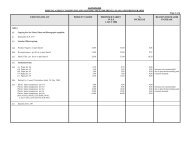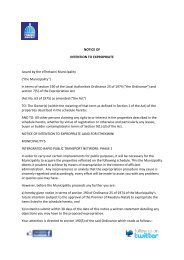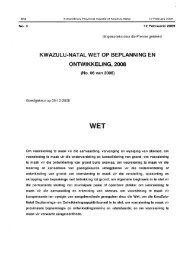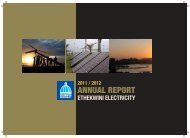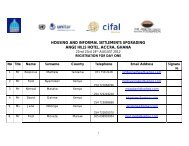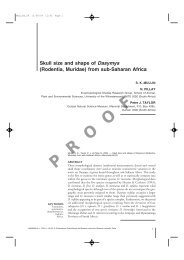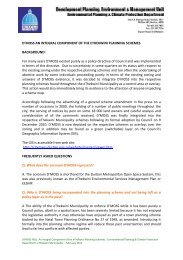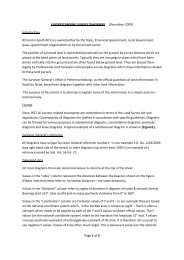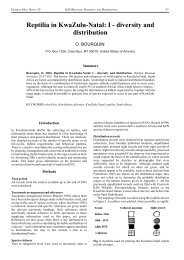Beautiful But Dangerous Poster Aliens - Durban
Beautiful But Dangerous Poster Aliens - Durban
Beautiful But Dangerous Poster Aliens - Durban
Create successful ePaper yourself
Turn your PDF publications into a flip-book with our unique Google optimized e-Paper software.
<strong>Beautiful</strong> <strong>But</strong> <strong>Dangerous</strong><br />
Invasive Alien Plants of <strong>Durban</strong><br />
and the Eastern, Sub-tropical Region of South Africa<br />
with some Indigenous Alternatives<br />
Category 1<br />
Category 2<br />
Herbicide<br />
Biocontrol<br />
Poisonous<br />
Key<br />
Category 3<br />
No Category<br />
Note: category numbers are<br />
shown on each panel<br />
Note:<br />
HERBICIDES may be<br />
used to control most<br />
plants, but this is only<br />
shown for those species<br />
for which chemicals<br />
have been registered.<br />
BIOCONTROL options<br />
are shown only for<br />
species where biocontrol<br />
is effective.<br />
New Weed & Invader Plant Legislation<br />
By the year 2000, 10 million hectares of land in South<br />
Africa had been invaded by alien plants. Alien plants<br />
have numerous impacts:<br />
!They can increase flood damage.<br />
!They compete with agricultural crops.<br />
!They displace indigenous plants and animals.<br />
!They increase the loss of water from catchments.<br />
!They increase the severity of fires.<br />
!They expand the range of disease-causing organisms.<br />
Despite raising almost R 1 billion to date through<br />
national government programmes and working at<br />
unprecedented levels, we are not reducing the extent<br />
of the invasion. In recognising the threats posed by<br />
invasive plants, the national Department of Agriculture<br />
has drafted regulations and listed weeds and alien<br />
<strong>Durban</strong> Unicity Unicity<br />
invader plants under the Conservation of Agricultural<br />
Resources Act.<br />
The list contains about 200 plants grouped into three<br />
categories:<br />
Category 1<br />
Weeds which may not be grown and<br />
must be controlled.<br />
Category 2 Invader plants with commercial or utility<br />
value, which may only be grown with a<br />
permit under controlled circumstances.<br />
Category 3<br />
Invader plants, which have amenity value<br />
and which may be grown, but not planted,<br />
propagated, imported or traded. You may not<br />
grow Category 3 plants within 30 metres of watercourses<br />
and the Department may instruct you to control<br />
Category 3 plants in other areas.
This <strong>Poster</strong>’s Objective<br />
Prevention of alien plant invasions is far<br />
cheaper than control or eradication.<br />
This poster profiles some of the most aggressive<br />
weed and invader plants in the <strong>Durban</strong><br />
Unicity area. Another poster in the series<br />
covers problem plants that are often used in<br />
horticulture.<br />
The plants on this poster were selected using<br />
these criteria:<br />
!They have or are expected to invade large<br />
parts of <strong>Durban</strong> and are likely to do so in<br />
other sub-tropical parts of South Africa.<br />
!They are potential transformers of natural<br />
habitats.<br />
Pearl Acacia (grey) and Triffid Weed (pale<br />
green) stand out on a slope dominated by weeds.<br />
Each Triffid Weed plant produces over a million<br />
seeds a year and the species is coastal KZN's<br />
worst weed.<br />
Yellow Bells tree with saplings escaping cultivation.<br />
A global survey of 1060 plant invasions<br />
found that in 59 % of the cases horticulture was<br />
the source.<br />
Control and Eradication<br />
Extent of the Problem<br />
In practice a combination of mechanical, chemical and<br />
biocontrol methods are used to combat alien plants.<br />
However, where infestations are light or cover relatively<br />
small areas, control is best achieved by mechanical<br />
means. Tackle light infestations first and then denser<br />
infestations.<br />
Small plants may be pulled out at the roots especially<br />
when the soil is moist. Larger plants may need to be<br />
dug out at the roots. The secret to success is to tackle<br />
the job in a planned way and to diligently follow-up to<br />
remove seedlings and regrowth.<br />
For more serious problems herbicides and/or biological<br />
control, using natural predators or pests, may be used. It<br />
is recommended that professional advice is sought<br />
before using these methods.<br />
Water Hyacinth covers the water at Clairwood Quarry.<br />
Water Hyacinth can double its mass every 18 days as<br />
well as produce over 5 000 long-lived seeds from each<br />
flower spike.<br />
South Africa has spent more than R 1 billion on national<br />
alien plant control and eradication programmes and is<br />
still not reducing the extent of the problem.
Achyranthes aspera<br />
Burweed<br />
Origin: Africa? now Pantropical<br />
Herb<br />
Indigenous alternatives:<br />
Asystasia gangetica<br />
Creeping Foxglove<br />
Hypoestes forskaolii<br />
White Ribbon Bush<br />
Justicia betonica<br />
Paper Plume<br />
Category 1<br />
Above left:<br />
A. conyzoides<br />
Above right:<br />
A. houstonianum<br />
Category 1<br />
Acacia longifolia<br />
Long-leaved Wattle<br />
Origin: Australia<br />
Shrub/Tree<br />
Indigenous alternatives:<br />
Euclea racemosa<br />
Bush Guarri<br />
Podocarpus latifolius<br />
Real Yellowwood<br />
Sapium integerrimum<br />
Duiker-berry<br />
Ageratum conyzoides and<br />
houstonianum<br />
Invading Ageratum and<br />
Mexican Ageratum<br />
Origin: South and Central<br />
America respectively<br />
Herb<br />
Category 1<br />
Indigenous alternatives:<br />
Tetraselago natalensis Natal Blue Haze<br />
Vernonia capensis<br />
Narrow-leaved Vernonia<br />
Vernonia natalensis Silver Vernonia
Albizia lebbeck<br />
Lebbeck Tree<br />
Origin: Tropical Asia<br />
Tree<br />
Indigenous alternatives:<br />
Acacia sieberiana<br />
Paperbark Thorn<br />
Albizia adianthifolia<br />
Flat-crown<br />
Albizia versicolor<br />
Large-leaved False-thorn<br />
Azolla filiculoides<br />
Red Water Fern<br />
Origin: North, Central<br />
and South America<br />
Floating Fern<br />
Indigenous alternatives:<br />
Ludwigia stolonifera<br />
Creeping Ludwigia<br />
Trapa natans<br />
Water Chestnut<br />
Utricularia inflexa<br />
Bladderwort<br />
Category 1<br />
Category 1<br />
Category 1<br />
Arundo donax<br />
Giant or Spanish Reed<br />
Origin: Mediterranean<br />
Reed<br />
Indigenous alternatives:<br />
Miscanthus capensis<br />
East-coast Broom Grass<br />
Phragmites australis<br />
Common Reed<br />
Typha capensis<br />
Bulrush
Cardiospermum grandiflorum<br />
Balloon Vine<br />
Origin: Tropical<br />
America<br />
Climber<br />
Category 1<br />
Indigenous alternatives:<br />
Clematis brachiata<br />
Traveller's Joy<br />
Jasminum angulare<br />
Wild Jasmine<br />
Rhoicissus rhomboidea<br />
Glossy Forest Grape<br />
Cestrum laevigatum<br />
Inkberry<br />
Origin: South America<br />
Shrub/Tree<br />
Indigenous alternatives:<br />
Kraussia floribunda<br />
Rhino-coffee<br />
Peddiea africana<br />
Poison Olive<br />
Psychotria capensis<br />
Black Bird-berry<br />
Category 1<br />
Caesalpinia decapetala<br />
Mauritius Thorn<br />
Origin: Europe and Asia<br />
Shrub/Scrambler<br />
Indigenous alternatives:<br />
Acacia kraussiana<br />
Coast Climbing Thorn<br />
Adenopodia spicata<br />
Spiny Splinter Bean<br />
Caesalpinia bonduc<br />
Grey Nickernut Creeper<br />
Category 1
Above: Young plants<br />
Eichhornia crassipes<br />
Water Hyacinth<br />
Origin: South and Central America<br />
Floating Plant<br />
Indigenous alternatives:<br />
Nymphaea lotus<br />
White Waterlily<br />
Nymphaea nouchali<br />
Blue Waterlily<br />
Nymphoides thunbergiana<br />
Small Yellow Waterlily<br />
Category 1<br />
Above: examples of three colour forms<br />
Category 1<br />
Chromolaena odorata<br />
Triffid Weed<br />
Origin: Central and<br />
South America<br />
Shrub/Scrambler<br />
Indigenous alternatives:<br />
Chrysanthemoides monilifera<br />
Bush-tick Berry<br />
Peristrophe cernua<br />
False Buckwheat<br />
Tecoma capensis<br />
Cape Honeysuckle<br />
Lantana camara<br />
Tickberry/Lantana<br />
Origin: Central and South<br />
America<br />
Shrub/Scrambler<br />
Indigenous alternatives:<br />
Chrysanthemoides monilifera<br />
Bush-tick Berry<br />
Peristrophe cernua<br />
False Buckwheat<br />
Plumbago auriculata<br />
Plumbago<br />
Category 1
Litsea glutinosa<br />
Indian Laurel<br />
Origin: Tropical Asia<br />
Tree<br />
Indigenous alternatives:<br />
Bridelia micrantha<br />
Mitzeeri<br />
Protorhus longifolia<br />
Red Beech<br />
Trichilia dregeana<br />
Forest Mahogany<br />
Myriophyllum aquaticum<br />
Parrot's Feather<br />
Origin: South America<br />
Aquatic Plant<br />
Indigenous alternatives:<br />
Ludwigia stolonifera<br />
Creeping Ludwigia<br />
Sium repandum<br />
Water Parsnip<br />
Trapa natans<br />
Water Chestnut<br />
Category 1<br />
Category 1<br />
Montanoa hibiscifolia<br />
Tree Daisy/Montanoa<br />
Origin: Central America<br />
Shrub/Tree<br />
Indigenous alternatives:<br />
Dombeya burgessiae<br />
Pink Wild Pear<br />
Rothmannia globosa<br />
September Bells<br />
Xylotheca kraussiana<br />
African Dog-rose<br />
Category 1
Pereskia aculeata<br />
Barbados Gooseberry/Pereskia<br />
Origin: South and Central America<br />
Climber<br />
Indigenous alternatives:<br />
Acacia kraussiana<br />
Coast Climbing thorn<br />
Combretum bracteosum<br />
Hiccup Nut<br />
Podranea ricasoliana<br />
Port St John's Creeper<br />
Nerium oleander<br />
Oleander<br />
Category 1<br />
Origin: Mediterranean<br />
Shrub/Tree<br />
Indigenous alternatives:<br />
Acokanthera oblongifolia<br />
Dune Poison-bush<br />
Bauhinia galpinii<br />
Pride-of-De Kaap<br />
Brachylaena discolor<br />
Coast Silver Oak<br />
Opuntia monacantha<br />
Drooping Prickly Pear<br />
Origin: South America<br />
Succulent Shrub<br />
Indigenous alternatives:<br />
Aloe arborescens<br />
Krantz Aloe<br />
Crassula ovata<br />
Kerky-bush<br />
Portulacaria afra<br />
Porkbush<br />
Category 1<br />
Category 1
Young plants<br />
Psidium guineense and<br />
Psidium X durbanensis<br />
Brazilian and <strong>Durban</strong> Guavas<br />
Origin: Tropical America and<br />
South Africa respectively<br />
Shrub/Tree<br />
Indigenous alternatives:<br />
Eugenia natalitia<br />
Common Forest Myrtle<br />
Lagynias lasiantha<br />
Natal Medlar<br />
Vangueria infausta<br />
Wild Medlar<br />
Category 3<br />
Category 1<br />
Category 1<br />
Above: P. guineense<br />
Left: P. guineense<br />
Right: P. X durbanensis<br />
Pistia stratiotes<br />
Water Lettuce<br />
Origin: South America<br />
Floating Plant<br />
Indigenous alternatives:<br />
Nymphaea nouchali<br />
Blue Waterlily<br />
Nymphoides thunbergiana<br />
Small Yellow Waterlily<br />
Trapa natans<br />
Water Chestnut<br />
Category 1<br />
Salvinia molesta<br />
Kariba Weed<br />
Origin: South America<br />
Floating Fern<br />
Indigenous alternatives:<br />
Ludwigia stolonifera<br />
Creeping Ludwigia<br />
Ludwigia palustris<br />
Marsh Ludwigia<br />
Nymphoides thunbergiana<br />
Small Yellow Waterlily
Schinus terebinthifolius<br />
Brazilian Pepper Tree<br />
Origin: South America<br />
Tree<br />
Indigenous alternatives:<br />
Apodytes dimidiata<br />
White Pear<br />
Allophylus natalensis<br />
Dune False Currant<br />
Brachylaena discolor<br />
Coast Silver Oak<br />
Category 1<br />
Sesbania punicea<br />
Brazilian Glory Pea/<br />
Red Sesbania<br />
Origin: South America<br />
Shrub<br />
Indigenous alternatives:<br />
Erythrina humeana<br />
Dwarf Coral Tree<br />
Mundulea sericea<br />
Cork Bush<br />
Tephrosia grandiflora<br />
Large Pink Tephrosia<br />
Category 1<br />
Category 1<br />
Solanum mauritianum<br />
Bugweed<br />
Origin: South America<br />
Shrub/Tree<br />
Indigenous alternatives:<br />
Buddleja saligna<br />
False Olive<br />
Buddleja salviifolia<br />
Sagewood<br />
Solanum giganteum<br />
Healing-leaf Tree
Tecoma stans<br />
Yellow Bells<br />
Origin: Tropical America<br />
Tree<br />
Indigenous alternatives:<br />
Ochna natalitia<br />
Natal Plane<br />
Peltophorum africanum<br />
Weeping Wattle<br />
Thespesia acutiloba<br />
Wild Tulip Tree<br />
Acacia mearnsii<br />
Black Wattle<br />
Origin: Australia<br />
Tree<br />
Indigenous alternatives:<br />
Acacia robusta<br />
Brack Thorn<br />
Acacia karroo<br />
Sweet Thorn<br />
Acacia caffra<br />
Common Hook Thorn<br />
Category 2<br />
Category 1<br />
Category 1<br />
Tithonia diversifolia<br />
Mexican Sunflower<br />
Origin: Central America<br />
Shrub<br />
Indigenous alternatives:<br />
Berkheya speciosa<br />
Showy Thistle<br />
Euryops tysonii<br />
Tyson's Resin Bush<br />
Chrysanthemoides monilifera<br />
Bush-tick Berry
Eucalyptus grandis<br />
Saligna Gum<br />
Origin: Australia<br />
Tree<br />
Indigenous alternatives:<br />
Olea woodiana<br />
Forest Olive<br />
Syzygium cordatum<br />
Umdoni<br />
Syzygium guineense<br />
Water Pear<br />
Category 2<br />
Category 2<br />
Casuarina cunninghamiana<br />
Beefwood<br />
Origin: Australia<br />
Tree<br />
Indigenous alternatives:<br />
Brachylaena discolor<br />
Coast Silver Oak<br />
Dodonaea viscosa<br />
Sand Olive<br />
Psydrax obovata<br />
Quar<br />
Category 2<br />
Casuarina equisetifolia<br />
Horsetail Tree<br />
Origin: Pantropical<br />
Tree<br />
Indigenous alternatives:<br />
Brachylaena discolor<br />
Coast Silver Oak<br />
Dodonaea viscosa<br />
Sand Olive<br />
Psydrax obovata<br />
Quar
Pinus elliottii<br />
Slash Pine<br />
Origin: North America<br />
Tree<br />
Indigenous alternatives:<br />
Podocarpus falcatus<br />
Common Yellowwood<br />
Podocarpus latifolius<br />
Real Yellowwood<br />
Category 2<br />
Category 2<br />
Leucaena leucocephala<br />
Leucaena<br />
Origin: Tropical America<br />
Shrub/Tree<br />
Indigenous alternatives:<br />
Acacia karroo<br />
Sweet Thorn<br />
Sesbania sesban<br />
River Bean<br />
Trema orientalis<br />
Pigeonwood<br />
Populus X canescens<br />
Grey Poplar<br />
Origin: Europe and Asia<br />
Tree<br />
Indigenous alternatives:<br />
Brachylaena discolor<br />
Coast Silver Oak<br />
Terminalia sericea<br />
Silver Cluster-leaf<br />
Tarchonanthus camphoratus<br />
Wild Camphor Bush<br />
Category 2
Psidium guajava<br />
Guava<br />
Origin: Tropical America<br />
Shrub/Tree<br />
Indigenous alternatives:<br />
Eugenia natalitia<br />
Common Forest Myrtle<br />
Lagynias lasiantha<br />
Natal Medlar<br />
Vangueria infausta<br />
Wild Medlar<br />
Ricinus communis<br />
Castor-oil Bush<br />
Origin: Tropical Africa<br />
Shrub/Tree<br />
Indigenous alternatives:<br />
Cussonia nicholsonii<br />
Natal Coast Cabbage Tree<br />
Dombeya burgessiae<br />
Pink Wild Pear<br />
Dombeya tiliacea<br />
Forest Wild Pear<br />
Category 2<br />
Category 2<br />
Acacia podalyriifolia<br />
Pearl Acacia<br />
Origin: Australia<br />
Shrub/Tree<br />
Indigenous alternatives:<br />
Brachylaena discolor<br />
Coast Silver Oak<br />
Tarchonanthus camphoratus<br />
Wild Camphor Bush<br />
Terminalia sericea<br />
Silver Cluster-leaf<br />
Category 3
Melia azedarach<br />
Syringa<br />
Origin: Asia<br />
Tree<br />
Indigenous alternatives:<br />
Bersama lucens<br />
Glossy White Ash<br />
Ekebergia capensis<br />
Cape Ash<br />
Trichilia dregeana<br />
Forest Mahogany<br />
Senna didymobotrya<br />
Peanut <strong>But</strong>ter Cassia<br />
Origin: Africa<br />
Shrub<br />
Category 3<br />
Indigenous alternatives:<br />
Bauhinia tomentosa<br />
Bush Neat's Foot<br />
Calpurnia aurea<br />
Natal Laburnum<br />
Crotalaria capensis<br />
Cape Rattle-pod<br />
Category 3<br />
Morus alba<br />
White or<br />
Common Mulberry<br />
Origin: Asia<br />
Tree<br />
Category 3<br />
Indigenous alternatives:<br />
Croton sylvaticus<br />
Forest Fever-berry<br />
Ficus sur<br />
Broom Cluster Fig<br />
Trimeria grandifolia<br />
Wild Mulberry
Useful Contacts<br />
For advice and planning of control work:<br />
! Plant Protection Research Institute, Cedara, runs a short<br />
course on "Alien Plant Control for Land Managers".<br />
Tel: 033-355 9416 or 033-355 9413.<br />
E-mail: ntjg@natal1.agric.za<br />
! Your local District Conservation Officer, KZN Wildlife.<br />
Tel: 031-764 3515. E-mail: pattrici@kznncs.org.za<br />
! The Ecological Advice Division, KZN Wildlife,<br />
Pietermartizburg. Tel: 033-845 1999.<br />
! Alien Buster Campaign, Toll-free line: 0800 005 376.<br />
For information about the use of herbicides contact:<br />
! The Plant Protection Research Institute, Cedara. See above<br />
for details. Also http://www.nda.agric.za<br />
For information about the use of biocontrol contact:<br />
! The Plant Protection Research Institute, Pretoria.<br />
Tel: 012-329 3269 or 012-329 3770.<br />
Useful References<br />
! Botha, C. and Botha, J. Bring Nature Back to Your Garden. A<br />
WESSA Handbook with a chapter on alien weeds and lots of suggestions<br />
for indigenous alternatives.<br />
! Conservation of Agricultural Resources Act, 1983 (Act No. 43<br />
of 1983)<br />
! Guiding Principles for the Landscaping of the <strong>Durban</strong> Inner<br />
City and KwaZulu-Natal Coastal Belt. A <strong>Durban</strong> Metro publication<br />
available from the cashier at the City Engineer’s Building, 166 Old<br />
Fort Rd, <strong>Durban</strong>.<br />
! Grobler, H et al. A guide to the Use of Herbicides. 17th edition.<br />
Available from the National Department of Agriculture, Directorate:<br />
Communication, Pvt Bag X144, Pretoria, 0001.<br />
! Henderson, L. Alien Weeds and Invasive Plants. Published by the<br />
Plant Protection Research Institute of the Agricultural Research<br />
Council, Pretoria.<br />
! Moore, J. Eradicating Invading Alien Plants in KwaZulu-Natal.<br />
This is a cheap and useful publication available from WESSA at<br />
100 Brand Rd, Glenwood, <strong>Durban</strong>.<br />
! Olckers, T. et al. Biological Control of Weeds in South Africa<br />
(1990-1998). African Entomology. Memoir No. 1. Entomological<br />
Society of Southern Africa.<br />
Pennisetum purpureum<br />
Elephant Grass/<br />
Napier Fodder<br />
Origin: Tropical Africa<br />
Tall Grass<br />
Indigenous alternatives:<br />
Cymbopogon spp.<br />
Turpentine Grasses<br />
Miscanthus capensis<br />
East-coast Broom Grass<br />
Phragmites australis<br />
Phragmites Reed<br />
E-mail: riethdb@plant2.agric.za<br />
To find indigenous plants and professional contractors<br />
who remove alien plants:<br />
! The Botanical Society - KZN Coastal Branch.<br />
Fax: 031-201 9958. E-mail: plantnet@iafrica.com<br />
! The Wildlife and Environment Society of South Africa<br />
(WESSA) - KZN Region. Tel: 031-201 3126.<br />
E-mail: wlskzn@saol.com<br />
! Natural Areas Section, <strong>Durban</strong> Parks Department.<br />
Tel: 031-312 4466. E-mail: KateE@prscu.durban.gov.za<br />
! or visit these web sites:<br />
http://www.wildlifesociety.org.za<br />
http://environment.durban.gov.za<br />
http://parks.durban.gov.za<br />
http://www.botanicalsociety.org.za<br />
For Law Enforcement:<br />
! National Department of Agriculture, Directorate: Agricultural<br />
Land and Resource Management, Box 345, Pietermaritzburg,<br />
3200. Tel: 033-345 3515 or 033-345 3557.<br />
Acknowledgments<br />
The production of this resource was a joint effort between<br />
the <strong>Durban</strong> Unicity Environmental Management Branch<br />
and Parks Department, the Wildlife and Environment<br />
Society of SA, and the Botanical Society of SA.<br />
With additional assistance from:<br />
! Lesley Henderson of the Plant Protection Research Institute,<br />
Agricultural Research Council.<br />
! Geoff Nichols, Richard Symmonds, Penny Croucamp and Richard<br />
Boon who supplied photographs.<br />
Copies of this poster are available from:<br />
! <strong>Durban</strong> Unicity Environmental Management Branch, Development<br />
and Planning Building, 166 Old Fort Rd, <strong>Durban</strong>. Tel: 031-300<br />
2517.<br />
! <strong>Durban</strong> Botanic Gardens, Information Centre, 9A Sydenham Rd,<br />
<strong>Durban</strong>. Tel: 031-201 1303<br />
! Wildlife and Environment Society of SA, 100 Brand Rd,<br />
Glenwood, <strong>Durban</strong>. Tel: 031-201 3126.<br />
! Botanical Society of SA. Fax: 031-201 9958.<br />
Partners in Publishing - June 2001


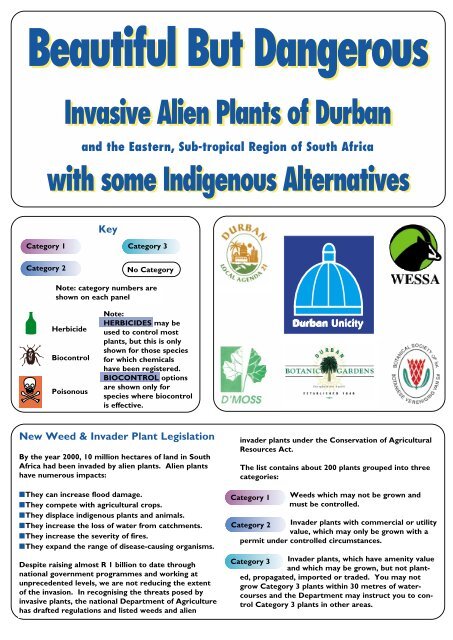
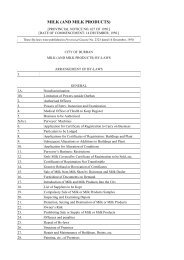
![INK Environmental Sustainability Booklet [19 MB] - Durban](https://img.yumpu.com/22025104/1/190x136/ink-environmental-sustainability-booklet-19-mb-durban.jpg?quality=85)

